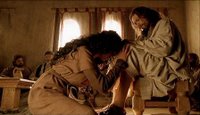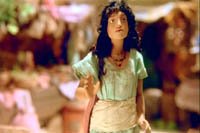Gospel Comparison:Wedding at Cana
 Sunday's lectionary gospel reading (in the Church of England at least) was the story of the Wedding at Cana and Jesus turning Water into Wine. In the CofE's lectionary it is one of the few passages from Jesus' ministry to appear every year, and so it's perhaps not surprising that it occurs in a good number of Jesus films.
Sunday's lectionary gospel reading (in the Church of England at least) was the story of the Wedding at Cana and Jesus turning Water into Wine. In the CofE's lectionary it is one of the few passages from Jesus' ministry to appear every year, and so it's perhaps not surprising that it occurs in a good number of Jesus films.What's interesting about the various portrayals is that, particularly in the later films, the filmmakers tend to take the opportunity to stress the otherness of Jesus' culture from our own. On occasion, however, this clashes with the film's overall portrayal of Jesus. It's somewhat jarring to see a blond-haired Jesus at a more typically middle-eastern wedding.
The Life and Passion of Jesus Christ (1905)
As is typical of this film, it prevents the action in a very straightforward manner. Jesus and his mother sit prominently at the front of the action, though the film's static camera, which frames the whole scene as if the audience is watching the action in a theatre, means that it's very much Jesus that is centre stage. The stone jars filled with wine are tiny - certainly not capable of holding 20-30 gallons. In contrast to the narrative where only the servants see what he is doing, here Jesus gestures to those at the back to get them to stand and see the action as if he's performing in a magic show.
From the Manger to the Cross (1912)
It's 100 years since Robert Henderson-Bland's Jesus came to our screens. In contrast to several portrayals this is not Jesus' first miracle, and it's one of the film's weaker moments. As with the above the miracle is performed somewhat theatrically and in full view of the guests. The chief steward is still surprised, but not so much because of an apparent breach of protocol. One notable innovation in this scene is that at the moment Jesus performs the miracle a light from above shines on his face.
Intolerance (1916)
The Judean Story, as director D.W. Griffiths called it, is the shortest of the four and is pure propaganda. The film as a whole is essentially campaigning against the temperance movement, showing the damage intolerance and its perpetrators have caused down the centuries. But it's the Jesus story where this intolerance coincides most closely with Griffith's biggest concern. In one intertitle he describes those objecting as "meddlers then as now". In another he adds a footnote explaining that "Wine was deemed a fit offering to God; the drinking of it a part of the Jewish religion". Not dissimilarly to Olcott's portrayal as Jesus conducts the miracle a cross shadow falls across him, only whereas the 1912 film used it to suggest divine approval, here it foreshadows Jesus' demise at the hands of intolerant humans.
The Gospel Road (1973) [pictured]
It would be over fifty years until this episode from the gospels was portrayed in the cinema, and when it came it was at the hands of one well acquainted with the pleasures and problems of alcohol. Johnny Cash's music provided the soundtrack for Robert Elfstrom to direct himself as Jesus. The scene has the surreal dreamy quality typical of much of the film which here reflects Cash's description of this episode as a parable (as some commentators think).
The wedding itself is very sparsely attended, and it's here that there's the greatest clash between the ultra blond Jesus and the effusive middle-eastern dancing. There's also a man smoking a hookah (water pipe) off to the side. Mary seems to be absent in this portrayal, although the camera does linger on a couple of women's faces as it becomes apparent that the wine has run out. Cash pipes up with his song "He turned the water into wine". A handful of particularly nice shots later (of the water being poured out and then changing colour) and Jesus has saved the day.
Last Temptation of Christ (1988)
This is one of the best scenes in the film, particularly because of the emphasis on the story's cultural context. Whilst, as noted above, this is fairly common for this episode, Scorsese nails it far more effectively than most of the other directors, despite Dafoe's blond locks.
The film also showed Jesus dancing, something absent previously but that most of the subsequent films would include, as well as a moment of levity as the miracle is performed. Nathanael, who has invited his new friends to the wedding, is convinced that the stone jars only contain water. Jesus is casual and playfully asks what's in the jars, before gently insisting that it's wine rather than water, and then raising a glass to his stupefied new disciple. Again Mary is absent, though Magdalene attends. When her attendance is challenged early on, Jesus uses the opportunity to talk about his father's feat where everyone is invited.
Jesus (1999)
In many ways Last Temptation is one of the foremost inspirations for Young's Jesus, using some of it's edginess, such as showing Jesus dancing at the wedding, whilst sanding down Scorsese/Kazantzakis's more controversial edges. This scene borrows heavily from Scorsese's, but adds in Mary, portraying her as a somewhat pushy mother catapulting her slacker son into messiahship (the moment Mary the mother of Jesus births the Christ one might say). Jesus is keen to stress that he's not ready, but for Andrew and John, who are having doubts, its the moment that they become convinced he is "the one". Eventually fed up with his reluctance ("My hour has not yet come") she lectures him ("it is time, for Andrew and for John") before forcing his hand telling a nearby servant "Jesus will help you with the wine". She ends by bossing poor Andrew around as well :"Drink Andrew, the cup you desired is here...He is the one Andrew. Have no fear in following him". The use of "he is the one" seems somewhat comical after The Matrix, but it's hardly the film's fault that it happened to be released the same year as one of the most talked about films of the decade.
The Revolutionary (1999)
Also released at the same time as The Matrix was the hilariously bad The Revolutionary. It also has a Jesus who dances, but here in contrast to the exuberance of Sisto and Dafoe, Jesus dances like a creep trying to hit on all the girls. When it becomes clear that the wine has run out Mary (who looks about the same age as Jesus) begs "please they'll be disgraced", whilst the hostess laments "How could this happen? I can't believe it". All of which at least provides a bit of cultural commentary about the severity of such a shortage. The scene is overshadowed however by the ridiculously snobby steward "you can't be serious" and his 'dramatic' change of heart - "This is the best wine I have ever tasted". This exaggeration of the text reflects the common interpretation that this 'sign' is about the wine of Christianity replacing the water of Judaism.
Mary, Mother of Jesus (1999)
Also released in 1999 was Mary, Mother of Jesus. The film makes a few interesting references in this scene. Firstly that the wedding in question is that of Jesus' cousin Joses, reflecting the Catholic interpretation that the brothers of Jesus named were actually his cousins (the precise meaning of the Greek word here is disputed). Secondly Mary Magdalene and Mary, mother of Jesus discuss Peter's view that women shouldn't "be allowed to follow the master". Mary asks Magdala what Jesus said: "that women are fit to guide becuase they raise our sons".
It's difficult to know what to make of this. Directing Peter's comments towards Mary Magdalene evokes the Gospel of Mary, although I'm not sure this is deliberate. But what is particularly interesting is how this relates to the issue of women priests. Peter could be read as a stand-in for the pope and, by extension, the Roman Catholic church. By getting Jesus to disagree the (Catholic) filmmakers might be offering a critique of the church's official church. But on closer inspection, Peter's words go far beyond Catholic teaching, denying the right for women even to be followers. Jesus' reply, in contrast, permits women to guide, but falls far short of condoning priesthood.
Gospel of John (2003)
After all that Saville's Gospel of John is rather unremarkable. Perhaps the most interesting aspect is the use of the Good News Version of the Bible, providing a somewhat softer response from Jesus after Mary's initial comment.
Labels: Gospel Comparisons, Intolerance


















